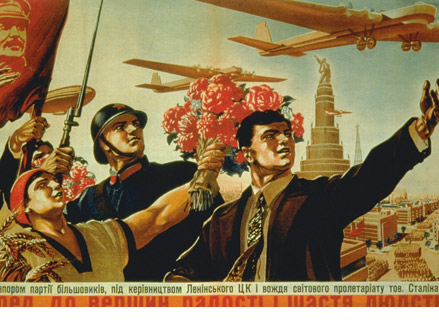


Seeds of Tyranny
by Philip Lee Williams
Intro
|
Alike But Different
|
Embraced By the People
|
Beyond Democracy
|
Cautious Optimism

![]()
A Distinguished Career in Brief
Embraced by the People
Roberts, who came to UGA in 1988 and served as head of the history department from 1993 to 1998, reminds his students and readers that the totalitarian states of World War II didn’t start with the war. In fact, the Soviet communist regime predated it by 22 years, the Italian fascist regime by 17 years and the German Nazi regime by six years. The Holocaust developed from within the wartime framework, but many of the images that continue to haunt us—of ritualistic spectacle and mind control, jackboots, prison camps—long preceded the war.
People still have a difficult time understanding how the triple threat of fascism, Nazism and Stalinist communism arose and how ordinary—“decent”—citizens allowed purges, concentration camps and wanton slaughter. “Just saying that only evil led to it is trivial,” Roberts says. “The key is to zero in on what was specific to totalitarianism, where it came from, why it emerged when it did and why it was so seductive.”

The text at the bottom of this political poster translates as, "Under the leadership of the Bolshevik party, under the guidance of the Leninist Central Committee and the sacred leader of the proletariat Comrade Stalin -- Onward to the heights of joy and happiness of mankind."
That last aspect—its seductiveness—may come as a surprise to observers who believe totalitarianism evolves in secret and against the will of the people. Roberts argues that many within the countries’ populations embraced the promises of the ruling parties—a troubling truth that is one reason why we need a “reconceptualization” of how such states began.
The term “totalitarianism” originated in Italy and was made popular by philosopher Giovanni Gentile, himself an enthusiastic fascist, but historians and political scientists since the 1920s have used it to describe states that regulate almost every aspect of society, public and private. The term became part of everyday speech with the 1951 publication of The Origins of Totalitarianism by political theorist Hannah Arendt, a book that is still required reading in some college courses.
In his own book The Totalitarian Experiment, Roberts traces the 19th-century intellectual foundations of totalitarianism, but he concludes that only with World War I did it become possible that the totalitarian direction would actually be taken. “The novel political departures in Russia, Italy and Germany grew directly from that war, to some degree playing off each other as they did so,” he says. And yet each of the regimes followed different paths in “the era of the tyrannies,” from their dramatic ascents to their inevitable collapses.
Intro
|
Alike But Different
|
Embraced By the People
|
Beyond Democracy
|
Cautious Optimism
For comments or for information please e-mail: rcomm@uga.edu
To contact the webmaster please email: ovprweb@uga.edu
![]()